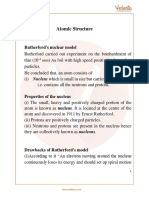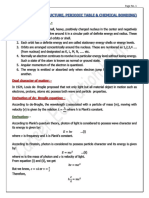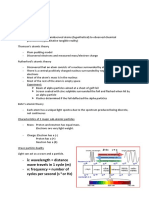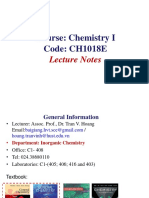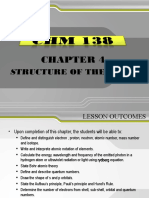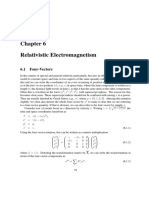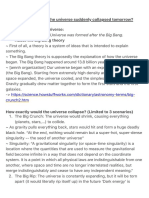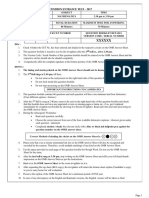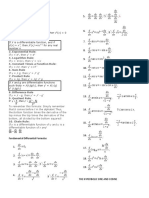Subject : Chemistry Topic : Atomic Structure Solutions
(1) (B). Atomic number = no. of protons in nucleus 40 40
are isobars because they have
19 K and 20 Ca
= no. of electrons
same atomic mass (40).
Nucleus has neutron and proton. Neutron is the (5) (C). According to de-Broglie equation
neutral particle and proton is positively charged
particle. h 6.62 1034
= 10–5 m
Atomic number is equal to the electrical charge mv 6.62 1029 103 103
of the nucleus because of presence of electrons (6) (C). H line is formed when electron jumps from 3d
in outer shells. orbit to 1st orbit in Lyman series.
(2) (C). Schrodigner : He put forward new model of n1 = 1, n2 = 3
atom by taking into account the de-Broglie
concept of dual nature of matter and (7) (C). The hydride ion is H– and its configuration is
Heisenberg’s uncertainty principle. He described 1s2.
the motion of electron in three dimensional space (8) (C). Mass of neutron = 1.675 × 10–24g = 1.008u,
in form of mathematical equation known as charge = 0
Schrodinger wave equation. Mass of electron = 9.11 × 10–28g,
de-Broglie : According to him all material Charge unit negative = – 1.602 × 10–19C
particles possess wave character as well as Proton has mass of 1.677 × 10–24g = 1.007 u
particle character. and proton has one unit positive charge
h
de-Broglie equation. = 1.602 × 10–19C
mv (9) (C). According to Aufbau principle increasing order
where, = wavelength, h = Planck’s constant, of energy of various orbitals is
m = mass of particle, v = velocity of particle. 1s, 2s, 2p, 3s, 3p, 4s 3d, 4p, 5s, etc.
Davission and Germer : They carried out Therefore,
experiment to show the wave character of 2s 2p
electrons. They observed when a beam of
electrons is allowed to fall on the surface of
nickel crystal and scattered or the reflected rays is not obeyed by Aufbau principle. Without fully
are received on photographic plate, a diffraction filling of s-subshell electron cannot goes p-
pattern similar to that of X-rays is obtained. subshell in ground state of atom.
Since X-rays are electromagnetic rays, it means (10) (C). Electronic configuration of Mn (25) is
electrons have wave character also. 1s2, 2s2, 2p6, 3s2, 3p6, 4s2, 3d5
Heisenberg uncertainty principle : It states Electronic configuration of Mn 2+ is
that position and momentum of an electron 1s2, 2s2, 2p6, 3s2, 3p6, 3d5 or [Ar] 3d5 4s0
cannot be measured accurately and (11) (B). In 3Li2+, number of electrons = 1,
simultaneously. n=1
Correct answer is (C) because wave nature of
(1)2 0.53 0.53
electron is demonstrated by Davission and Radius = 0.17Å
Germer. 3 3
1 1
(3) (D). R
n12 n 22 hc
(12) (C). The energy of photon, E = = 3.03 × 10–19
For Balmer series n 1 = 2 for 4th line in Balmer
series n2 = 6 6.626 1034 3 108
or
R = 109677 cm–1 3.03 1019
1 1 1 1 19.878
109677 2 2 109677 or 107 6.656 107 m = 656 nm
2 6 4 36 3.03
24372 cm1
(13) (A). The centripetal force is supplied by electrostatic
force of attraction i.e.
(4) (B).
mv2 ze2 mv2 ze2
(a) Isotopes : They are atoms of same element 2 or
which have same atomic numbers but different r r r r
atomic masses eg, 11 H, 12 H and 13H . 1 2 ze 2
1 ze 2
ze2
or mv
(b) Isobars : They are atoms of different elements 2 r 2 r r
which have different atomic numbers but similar
atomic masses. 1 ze2
3.4eV
(c) Isotones : These are atoms of different elements 2 r
which have same number of neutrons. Their
atomic numbers and atomic masses both are
12 15
different. eg, 6 C and 7 N .
1
� 1 ze2 (18) (C), (19) (A), (20) (C).
K.E. = = + 3.4 eV h h
2 r (i) x p p2
hc c 4 4
(14) (D). E h or h 1 h
m2 v2 v
4 2m
3 108
= 3.75 × 10–8m h h
8 10
15
(ii) x , xp
In nanometer = 37.5nm 4m 4
which is closest to 4 × 101 h h mh
p , p
E 4m 4 4
(15) (A). From equation En = 1 , the energy change of a
n2 150
H atom that goes from initial state of quantum (iii) D.B. Å 5Å and
6
number ni to a final state of quantum number n f
h h h
1 x.p ; p or p 2
E1 E1 1 4
is E = Ef –Ei =
E1
n12 n12 n f2 n i2 h h
x
Hence ni = 1, nf = 3, Ei = 3, E1 = – 13.6 eV 2 4
1 1 1 109 1 2.5
E = – 13.6 2 2 eV = 12.08 eV. 1010
3 1 2 4 4
h 0.625Å
(16) (D). We know that x.p
4 (21) 13.
h K L M N
x.mv M (26) 1s2, 2s22p6, 3s23p63d6 4s2
4
M3+ 1s2, 2s22p6, 3s23p63d5 4s0
h
v Hence, 13 electrons are present in the M-shell of
4xm M3+ state.
6.626 1034 66 (22) 17. Atomic number of bromine is 35.
v 107
4 0.1 10 10 31
9.11 10 4 9 Br = 1s2, 2s2, 2p6, 3s2, 3p6, 4s2, 3d10, 4p5
Total number of p-electrons in bromine is 17.
= 5.79 × 106 m/s (23) 25. The total number of atomic orbitals (total m) in
(17) (B). Magnetic quantum no. represents the orientation nth shell is equal to n2.
of atomic orbitals in an atom. For example, px, So, in the fifth shell = 52 = 25
py & pz have orientation along X-axis, Y-axis (24) 3. Atomic no. 17 = 1s2, 2s2, 2p6, 3s2, 3p5
and Z-axis. Valence shell has 3s2 and 3p5 orbitals.
3s 3p
Valence shell has 3 paired electrons.
(25) 1. Quantum number n = 3, = 2, m = + 2 represent
1
an orbital with s = ± 3d xy or 3d 2 2
2 x y
–
which is possible only for one e .





